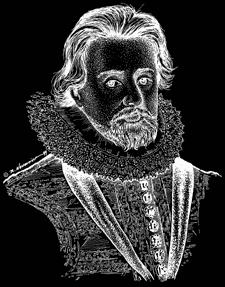










(also known as Codex
Aleph)
Codex Sinaiticus was discovered by Constantin von Tischendorf, a German evolutionist theologian, at St. Catherine’s Monastery at Mount Sinai. He discovered the first part in 1844 and the second part in 1859.
Following is the story of how Tischendorf found the Codex Sinaiticus:
| |
"In the year 1844, whilst travelling under the patronage of Frederick Augustus King of Saxony, in quest of manuscripts, Tischendorf reached the Convent of St. Catherine, on Mount Sinai. Here, observing some old-looking documents in a basketful of papers ready for lighting the stove, he picked them out, and discovered that they were forty-three vellum leaves of the Septuagint Version. Some enemies of the defense of the King James Bible have claimed that the manuscripts were not found in a "waste basket," but they were. That is exactly how Tischendorf described it. "I perceived a large and wide basket full of old parchments; and the librarian told me that two heaps like this had been already committed to the flames. What was my surprise to find amid this heap of papers..." (Narrative of the Discovery of the Sinaitic Manuscript, p. 23). John Burgon, who was alive when Tischendorf discovered the Codex Sinaiticus and also personally visited St. Catherine's to research ancient manuscripts, testified that the manuscripts "got deposited in the waste-paper basket of the Convent." (The Revision Revised, 1883, pp. 319, 342) |
So, it certainly appears to me that the Orthodox monks evidently had long since decided that the numerous omissions and alterations in the manuscript had rendered it useless and had stored it away in some closet where it had remained unused for centuries. Yet Tischendorf promoted it widely and vigorously as representing a more accurate text than the thousands of manuscripts supporting the Textus Receptus. Furthermore, he assumed that it came from about the 4th century, but he never found any actual proof that it dated earlier than the 12th century.
Consider these facts and oddities relating to the Codex Sinaiticus:
-
The Sinaiticus was written by three different scribes and was corrected later by several others. (This was the conclusion of an extensive investigation by H.J.M. Milne and T.C. Skeat of the British Museum, which was published in Scribes and Correctors of Codex Sinaiticus, London, 1938.) Tischendorf counted 14,800 corrections in this manuscript (David Brown, The Great Uncials, 2000). Dr. F.H.A. Scrivener, who published A Full Collation of the Codex Sinaiticus in 1864 testified: "The Codex is covered with alterations of an obviously correctional character—brought in by at least ten different revisers, some of them systematically spread over every page, others occasional, or limited to separate portions of the manuscript, many of these being contemporaneous with the first writer, but for the greater part belonging to the sixth or seventh century." Thus, it is evident that scribes in bygone centuries did not consider the Sinaiticus to represent a pure text. Why it should be so revered by modern textual critics is a mystery.
-
A great amount of carelessness is exhibited in the copying and correction. "Codex Sinaiticus 'abounds with errors of the eye and pen to an extent not indeed unparalleled, but happily rather unusual in documents of first-rate importance.' On many occasions 10, 20, 30, 40 words are dropped through very carelessness. Letters and words, even whole sentences, are frequently written twice over, or begun and immediately cancelled; while that gross blunder, whereby a clause is omitted because it happens to end in the same words as the clause preceding, occurs no less than 115 times in the New Testament." (John Burgon, The Revision Revised)It is clear that the scribes who copied the Codex Sinaiticus were not faithful men of God who treated the Scriptures with utmost reverence. The total number of words omitted in the Sinaiticus in the Gospels alone is 3,455 compared with the Greek Received Text (Burgon, p. 75).
- Mark 16:9-20 is omitted in the Codex Sinaiticus, but it was originally there and has been erased.
-
Codex Sinaiticus includes the apocryphal books (Esdras, Tobit, Judith, I and IV Maccabees, Wisdom, Ecclesiasticus) plus two heretical writings, the Epistle of Barnabas and the Shepherd of Hermas. The apocryphal Epistle of Barnabas is filled with heresies and fanciful allegorizing, claiming, for example, that Abraham knew Greek and baptism is necessary for salvation. The Shepherd of Hermas is a gnostic writing that presents the heresy that the "Christ Spirit" came upon Jesus at his baptism.
-
Lastly, Codex Sinaiticus (along with Codex Vaticanus), exhibits clear gnostic influence. In John 1:18 "the only begotten Son" is changed to "the only begotten God," thus perpetuating the ancient Arian heresy that disassociates the Son Jesus Christ with God Himself by breaking the clear connection between "God" of John 1:1 with "the Son" of John 1:18. We know that God was not begotten; it was the Son who was begotten in the incarnation.
Home
Does it Really
Matter?
Manuscripts
Codex
Sinaiticus
Codex
Vaticanus
Textus
Receptus
Westcott
& Hort
Is Older
Better?
Other Translations
Altered
Verses
Constantine
Origen
Tischendorf
Catholics & the Jesuits
![]()
![]()
